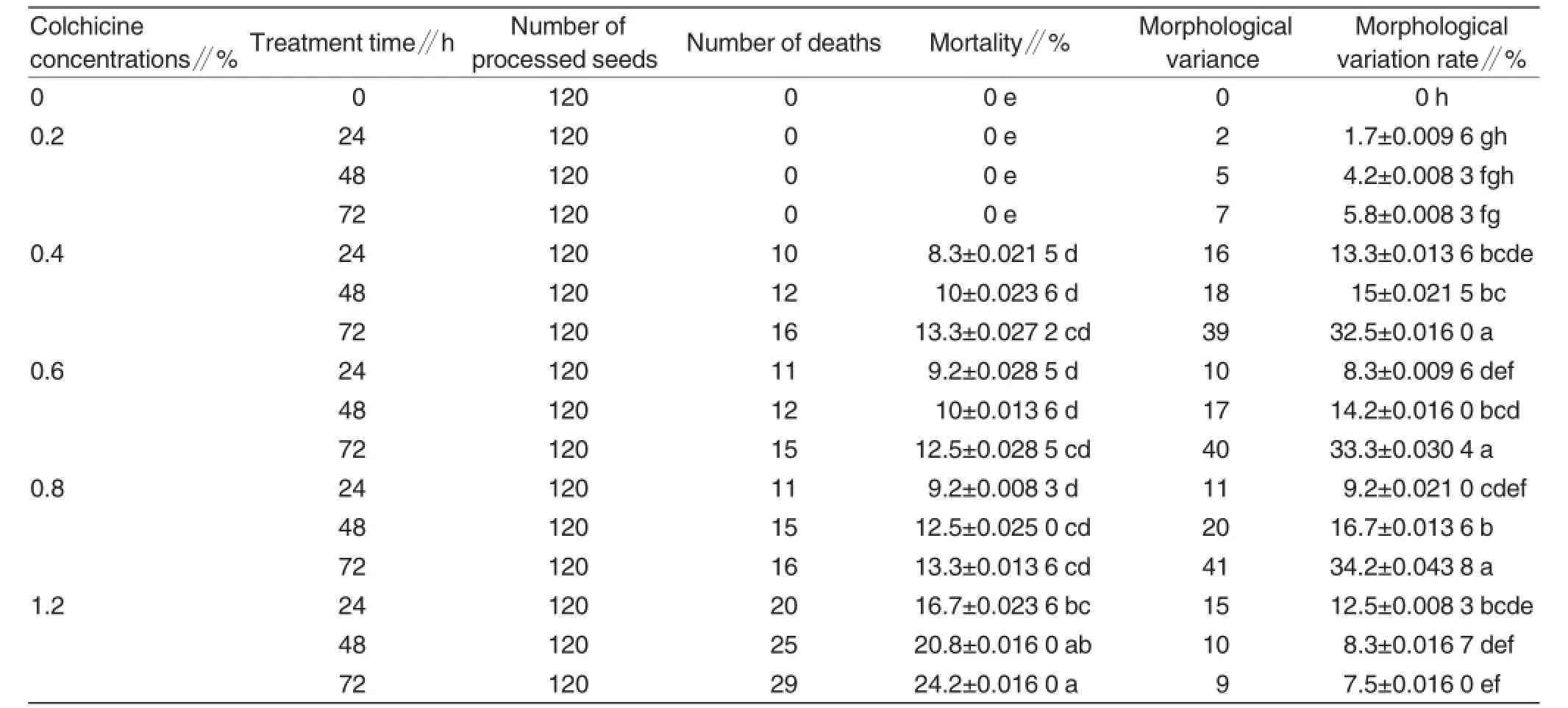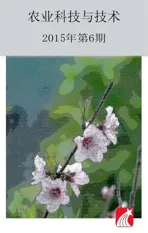Polyploidy Induction of Pteroceltis tatarinowii Maxim.
2015-02-05LinZHANGFengWANGZhongkuiSUNCuicuiZHURongweiCHEN
Lin ZHANG,Feng WANG,Zhongkui SUN,Cuicui ZHU,Rongwei CHEN
1.Academy of Forestry Taishan,Taian 271000,China;
2.Taian Shidai Technology Development Limited Company,Taian 271000,China;
3.Shandong Agricultural University,Taian 271018,China;
4.Management Committee of Taishan Scenic Area Taohuayu Spot,Taian 271000,China
Polyploidy Induction of Pteroceltis tatarinowii Maxim.
Lin ZHANG1*,Feng WANG1,Zhongkui SUN2,Cuicui ZHU3,Rongwei CHEN4
1.Academy of Forestry Taishan,Taian 271000,China;
2.Taian Shidai Technology Development Limited Company,Taian 271000,China;
3.Shandong Agricultural University,Taian 271018,China;
4.Management Committee of Taishan Scenic Area Taohuayu Spot,Taian 271000,China
[Objective]This study was conducted to obtain tetraploidPteroceltis tatarinowiiMaxim.with excellent ornamental traits.[Method]The stem apex growing points ofPteroceltis tatarinowiiMaxim.were treated with different concentrations of colchicine solution for different hours to figure out a proper method and obtain polyploids.[Result]The most effective induction was obtained by treatment with 0.6%-0.8%colchicine for 72 h with 34.2%mutation rate.Flow cytometry and chromosome observation of the stem apex growing point ofP.tatarinowiiMaxim.proved that the tetraploid plants were successfully obtained with chromosome number 2n=4x=36. [Conclusion]The result not only fills the blank of polyploid breeding ofP.tatarinowii, but also provides an effective way to broaden the methods of cultivation of fastgrowing,high-quality,disease-resilience,new varieties ofPteroceltis.
Pteroceltis tatarinowiiMaxim.;Tetraploid;Colchicine
P teroceltis tatarinowiiMaxim.is a deciduous arbor of family Ulmaceae,native to China.It is also an important indicator plant for calcium soil,a rare and protected tree of level three[1-2].It usually grows in an open forest near a river,in a valley or in limestone mountain regions and is mainly distributed in 19 provinces of China including Anhui,Zhejiang,Fujian and Hubei.P.tatarinowiiis resistant to moisture,drought and barren, so it is the pioneer plant of riparian regions,sandstone and limestone mountains[3].The plant itself has a high value of application.Its leaves can be used as high-level nutritional feed additives, its bark fiber is the main raw material of rice paper,and the hard and compact wood is a fine material to produce farm tools,furniture and for architectural use[4].In addition,P.tatarinowiihas great academic value for phylogenetic studies on Ulmaceae because it is a single species that only grows in China.
Chromosome is a gene carrier which determines the individual traits of an organism;when chromosome doubles,plants will generate chemical and morphological changes compared with their parents and possess greater physical adaptability and greater genetic plasticity compared with diploid[5-6].Thus,the majority of breeders paid much attention to polyploid breeding for a long time and there were many successful cases about polyploid induction[7].Currently, researches onP.tatarinowiihave focused on resistance testing,cultivation,reproduction and applications[8-9], and no report on polyploid breeding has been found,therefore,carrying out the study not only fills the blank of polyploid breeding ofP.tatarinowii,but also is an effective way to broaden the methods of cultivation of fast-growing, high-quality,disease-resilience,new varieties ofPteroceltis.
Materials and Methods
Materials
Harvested and collected seeds from the end of October to early November in 2012 were planted in plug trays after sand sprouting.
Methods
Induction of polyploidsSeedlings emerged in early April the following year.When cotyledons scratched and the first euphylla budded,we put cotton balls which had been dipped respectively in the colchicine solutions at concentrations of 0.4%,0.6%,0.8% and 1.2%on the growing points of stem tip for 24,48 and 72 h,respectively,and dropped 1-3 drops of colchicine solution once every morning and every evening,then covered them with plastic film and shade net.The cotton balls were removed and plants were washed with clean water to stop induction when it came to a predetermined time point from the first drop. Identification was conducted on the chromosome ploidy of the plants on which abnormal characters occurred (with thicker and rough leaves or a dwarf plant).
Identification of polyploidyThe leaves of the plants were picked,a ploidy analyzer was used to identify the chromosome ploidy of the samples,and the number of chromosomes of the stem tip cells was identified by conventional compression method of shoot tips,then the chromosomes were observed and imaged with an optical microscope of ZEISS.
Results and Analysis
Induction effects of colchicine on seeds of P.tatarinowii Maxim.
The phenotype variations of theseedlings gradually occurred in two main cases after more than 30 days’treatment of colchicine solution;one variation represents shorter petiole, reducing number of leaf sawtooth,and smaller leaf with an area of about 1/5 of ordinary size.The other represents similar traits of Pteroceltis polyploid, showing thicker,rough leaves and color-deepened leaves and so on.With colchicine concentration increased and induction time prolonged,the mortality rate was increased,among them, treatments with colchicine solution at the concentration of 0.6%and 0.8% for 72 h induced optimal results with the morphological variation rates of 33.3%and 34.2%,respectively,and the corresponding the mortality rates of 12.5%and13.3%,respectively.The morphological variation can be a preliminary indicator for polyploidy plants because the plants with variant morphological traits show a high rate of chromosome polyploidy.We considered that treating with colchicine solution at the concentration of 0.6%-0.4% for 72 h is the best way to induce Pteroceltis polyploid because a high or low concentration of colchicine solution has negative influence on the induction effect.
Identification of the quantity of DNA and the number of chromosome of variant plants
Flow cytometry was used to detect the quantity of cellular DNA of Pteroceltis diploid and tetraploid.The results showed that the values of the relative fluorescence density of diploid plants had a singlet at 50 while that of tetraploid had a singlet at 100,indicating the quantity of cellular DNA of tetraploid doubled compared with control.
We used the conventional compression method to detect the number of the chromosomes of the stem tip cells of Pteroceltis diploid growing under nature condition and the artificiallyinduced Pteroceltis tetraploid to identify the number of the chromosome of tetraploid and found that the number of chromosomes of diploid was 2n=2x= 18 while the number of chromosomes of colchicine-induced tetraploid that we got was 2n=4x=36,although there was a higher proportion of diploid and a certain percentage of chimeras.

Table 1Induction effects of colchicine concentrations and treatment time on seeds of P.tatarinowii Maxim.
Discussion
Using colchicine to artificially induce plant ploidy is one of the important ways to speed up the cultivation of new species and obtain new materials,the concentration of colchicine solution and the time of treatment are key factors to influence the effect of induction[10].Different species and types also greatly influence the rate of induction.The study of Zhang et al.[11]showed that the rate of induction of anthurium tetraploid reached 45.5% when it was cultivated in fluid medium containing colchicine at concentration of 0.2 g/L for 14 d.Though the germination rate would be reduced when taking seeds to induce polyploidy plants due to its hypertoxicity,this method has advantages over tissue culture because it is less poisonous to seeds,has shorter time to get polyploidy plants,robust plants and induce a higher survival rate of plants.The study of Zhang et al.[12]on eucommia seedlings showed that treatment of growing point with colchicine solution at concentration of 0.1%for 12 h was the optimal method,and the induction rate reached 36.7%.In our research, treatment with colchicine solution at concentration of 0.6%-0.8%for 72 h is the best combination,and the induction rate reaches 34.2%.
Chimeras occur sometimes during the process of inducing polyploidy by colchicine and their occurrence will influence induction rate of polyploid and genetic stability.In our experiment,three chimeric plants were detected simultaneously,which possess some abnormal pores.Meanwhile,we got eight tiny-leaf variant plants, whose leaf area was 1/8-1/5 of ordinary size over the same period.They were identified on chromosome number and were found not changed,remaining Pteroceltis diploid.There are a variety of methods for the identification of polyploid,the stem tip or root tip chromosome identification is a tradi-tional and reliable method,and cellular DNA detection by flow cytometry is increasingly adopted.In our study,both flow cytometry assay and chromosome counting were used to analyze the relative cellular DNA quantity and the number of chromosomes.The result shows that the relative cellular DNA quantity of tetraploid is twice of that of diploid;the number of chromosome of diploid is 2n=2x=18 while the number of chromosomes of tetraploid is 2n=4x=36.Tetraploid typically exhibits wider leaf,stouter,dark green leaf and crumpled surface of leaf;it grows slowly at first,but the growth rate speeds up after 30 d,and growth accelerates rapidly,and their leaves are significantly greater than those of diploid plants.
Reference
[1]ZHANG TL.1600 kinds of landscape plants and trees[M].Beijing:China Building Industry Press,2009.
[2]CHEN YM.Garden dendrology[M].Beijing:China Forestry Publishing House (CFPH),1990.
[3]LIU FM,MU HZ,LIU ZJ,et al.Inducing tetraploid ofBetula platyphyllawith different generations of seeds by colchicine[J].Journal of Beijing Forestry University,2013,35(3):84-89.
[4]KANG XY.Advances in researches on polyploid breeding of forest trees[J]. Journal of Beijing Forestry University, 2003,25(4):70-74.
[5]GAO P,LIN W,KANG XY,et al.Pollen chromosome doubling ofEucommia ulmoidesby colchicine[J].Journal of Beijing Forestry University,2004,26(4): 39-42.
Responsible editor:Qingqing YIN
[6]EINSPHAHR DW.Production and utilization of triploid hybrid aspen[J].Iowa State Journal of Research,1984,58(4): 401-409.
[7]HOU CY,FANG SZ,XUE JH,et al.The Effects of Drought stress on the oneyear seedling growth and physiology properties ofPteroceltis tatarinowii, Taxodium distichumandFraxinus velutina[J].Journal of Nanjing Forestry University,2003,27(6):103-106.
[8]FU XX,FANG SZ.A study on mechanism of dormancy and germination condition ofPteroceltis tatarinowiiMaxim.seeds[J].Journal of Plant resources and Environment,2002,11(1):9-13.
[9]FANG SZ,LI GY.The effects of management practice on above-ground biomass production and phloem production ofPteroceltis tatarinowiiMaxim. plantations[J].Journal of Plant Resources and Environment,2001,10(1): 21-24.
[10]ZHANG ZS,LI YH,JIANG L,et al.In vitrotetraploid induction and identification inAnthurium andraeanum[J].Acta Horticulturae Sinica,2007,34(3): 729-734.
[11]ZHANG LL,ZHANG SN,ZHANG HM,et al.Regeneration of autotetraploid broccoliin vitroculture and identification of the ploidy[J].Acta Horticulturae Sinica,2008,35(10):1517-1520.
[12]ZHANG SN,ZHANG LL,TANG J,ET AL.In vitroinduction of autotetraploid broccoli with colchicine[J].Acta Horticulturae Sinica,2009,36(11):1681-1684.
Responsible proofreader:Xiaoyan WU
Supported by Agricultural Seed Breeding Program of Shandong Province in 2014 ([2014]96).
*Corresponding author.E-mail:lkyzhanglin@163.com
Received:March 30,2015 Accepted:June 1,2015
杂志排行
Agricultural Science & Technology的其它文章
- Highly-efficient Stereo-cultivation Model in Kiwifruit Orchards Interplanting Konjak
- The Breeding of New Indica-japonica Intersubspecific Hybrid Rice Combination Chunyou 84
- Comparative Analysis between Triple Cross and Double Cross among Three Parents of Crop
- Optimization of Field Arrangement of Doublecropping Glutinous Sorghum and Soybean Intercropping Pattern
- Principal Component Analysis on Traits Related to Lodging Resistance of Plateau Japonica Rice
- Inheritance of Aroma of Good-quality Indica Type Rice PTGMS Line GHS and Its Application in Hybrid Rice Breeding
